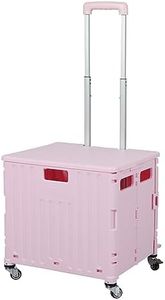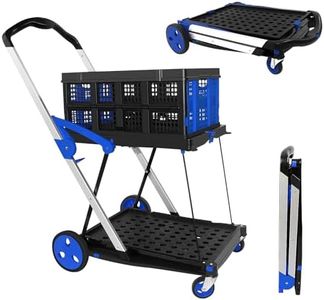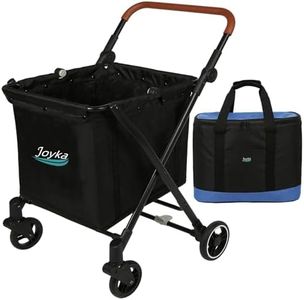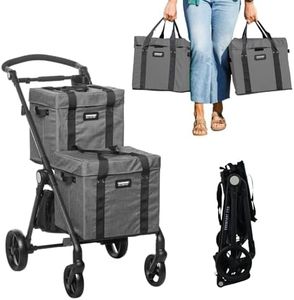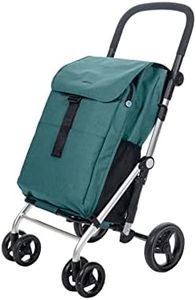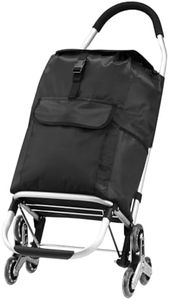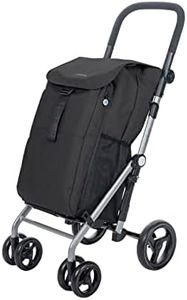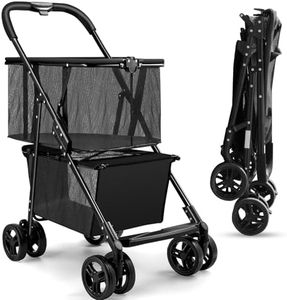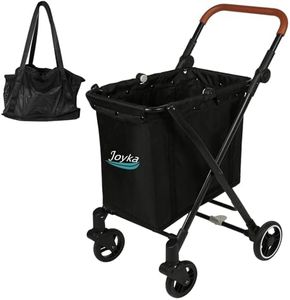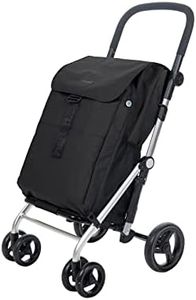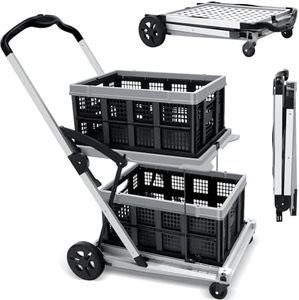We Use CookiesWe use cookies to enhance the security, performance,
functionality and for analytical and promotional activities. By continuing to browse this site you
are agreeing to our privacy policy
10 Best Grocery Carts
From leading brands and best sellers available on the web.Buying Guide for the Best Grocery Carts
Choosing the right grocery cart can make shopping trips much easier and more comfortable, especially if you do large or frequent shopping runs. The ideal grocery cart should be easy to maneuver, fit your typical amount of groceries, and match your preferences for portability and storage. Since people have different needs—some shop for big families, others for just themselves, and some live in apartments with steps or limited storage—it’s important to consider how and where you’ll use your cart. Pay attention to the main features of grocery carts to make sure you select one that best supports your shopping habits.CapacityCapacity refers to how much the grocery cart can hold, usually measured in liters, cubic feet, or as a general small, medium, or large size. This spec is important because a cart that's too small may not fit all your groceries, while one that's too large can be difficult to maneuver or store. Small carts work well for single people or those who shop often and carry just a few bags. Medium carts are a good balance for weekly shoppers with moderate loads. Large carts are suited to big families or bulk shoppers who need to carry a lot in one trip. Think about how many groceries you usually buy, your transportation method (car, public transport, walking), and your storage space at home to determine the right capacity.
Wheel DesignWheel design includes the number, size, and type of wheels on the cart. This matters because it affects how easily you can push, pull, and steer the cart, especially over different surfaces. Smaller plastic wheels work well indoors and on smooth floors, but they can struggle on uneven pavement or curbs. Larger rubber or foam wheels handle outdoor paths, steps, and rough surfaces better. Some carts have swivel wheels for easier steering, while others have fixed wheels for more stability in a straight line. Consider where you usually shop and how far you need to travel with your cart. If you'll tackle stairs or bumpy sidewalks, look for larger, sturdier wheels. For indoor-only use, smaller wheels may suffice.
Foldability and StorageFoldability refers to how the cart packs down for storage in your home or vehicle. This matters if you have limited space or need to transport the cart when not in use. Some units fold flat to fit in a closet or trunk, while others have fixed frames that may require more storage room. Carts are commonly divided into fully collapsible models, semi-folding types, and rigid (non-folding) designs. If space is tight at home or you need to carry the cart in your car or on public transport, foldability is essential. Otherwise, a rigid cart may offer more durability but needs more storage consideration.
Handle Comfort and AdjustabilityHandle comfort and adjustability affect how easy and pleasant the cart is to use, especially for longer shopping trips. Handles may be made from plastic, foam, or rubber and can be straight or ergonomically shaped. Some carts allow you to adjust the handle height, which is great for people of different heights or those with back problems. Shorter fixed handles can cause discomfort if you must bend, while longer or adjustable ones fit a wider range of users. Think about your height and how long you plan to use the cart per trip. If you’re tall or want more comfort, an adjustable, cushioned handle is a smart choice.
Weight and Build MaterialThe cart's weight and the material it's made from influence overall durability, ease of carrying, and lifespan. Common materials are steel, aluminum, and heavy-duty plastic. Lighter carts are easier to move, lift, and transport but may not handle heavy groceries as well as sturdier carts. Heavier carts hold more and tend to last longer with regular use, but can be hard to lift into cars or up stairs. If you need to carry your cart on public transportation or up steps, look for a lightweight material like aluminum. If you shop infrequently but buy a lot each time, a heavier, more robust cart may be better.
Extra FeaturesExtra features like removable bags, cup holders, hooks for bags, or weather-resistant covers can add convenience or protection for your groceries. Some carts even come with insulated sections for frozen items or pockets for small valuables. While not always essential, these features can make shopping easier if you have special needs, such as keeping items cold or carrying personal items along. Consider what added features would genuinely improve your experience and pick a cart that matches those needs without unnecessary extras.

